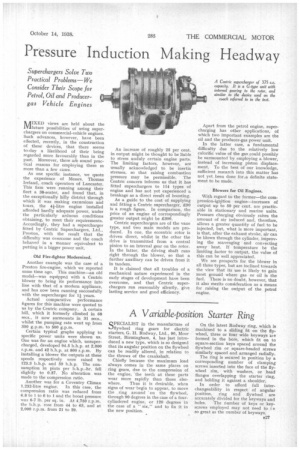Pressure Induction Making Headway
Page 41

If you've noticed an error in this article please click here to report it so we can fix it.
NAIXED views are held about the 1Y1future possibilities of using superchargers on commercial-vehicle engines. Such advances, however, have been effected, recently, in the construction of these devices, that there seems to-day a likelihood of their being regarded more favourably than in the past. Moreover, there atie sound practical reasons for employing them in more than a few cases.
As one specific instance, we quote the experience of Messrs. Thomas Ireland, coach operators of Lancaster. This firm were running among their fleet a 38-seater, and found that, in the exceptionally hilly district through which it was making excursions and tours, the 44-litre engine installed afforded hardly adequate power, under the particularly arduous conditions obtaining, to meet their requirements. Accordingly, they had a supercharger fitted by Centric Superchargers, Ltd., Preston, with the result that the difficulty was overcome and the coach behaved in a manner equivalent to putting in a bigger power unit.
Old Fire-fighter Modernized.
Another example was the case of a Preston fire-engine, which we reported some time ago. This machine—an old model—was equipped with a Centric blower to bring its performance into line with that of a modem appliance, and has now been running successfully with the supercharger for 14 years.
Actual comparative performance figures for this machine were quoted to us by the Centric company. A certain hill, which it formerly climbed in 68 secs.. it now surmounts in 31 secs., whilst the pumping rate went up from 350 g.p.m. to 500 g.p.m.
Certain typical graphs applying to specific power units were shown us. One was for an engine which, unsupercharged, developed 94.5 b.h.p. at 2,000 r.p.m. and 42 b.h.p. at 800 r.p.m. By installing a blower the outputs at these speeds respectively were raised to 123.3 b.h.p. and 59 b.h.p. The consumption in pints per b.h.p.-hr. fell slightly to 0.37. No alteration was made to the compression ratio.
Another was for a Coventry Climax
1.232-litre engine. In this case, the compression ratio was reduced from 6.8 to 1 to 6 to 1 and the boost pressure was 6-7 lb. per sq. in. At 4,750 r.p.m. the b.h.p. rose from 44 to 63, and at 2,000 r.p.m. from 21 to 29.
An increase of roughly 25 per cent. in output might be thought to be liable to stress unduly certain engine parts. The limiting factors, however, are usually acknowledged to be inertia stresses, so that raising combustion pressure may be permissible. The Centric concern informs us that it has fitted superchargers to 114 types of engine and has not yet experienced a breakage as a direct result of boosting.
As a guide to the cost of supplying and fitting a Centric supercharger, £90 is a rough figure. In comparison, the price of an engine of correspondingly greater output might be £300.
Centric superchargers are of the vane type, and two main models are produced. In one, the eccentric rotor is driven direct, whilst in the other the drive is transmitted from a central pinion to an internal gear on the rotor. In the latter, the driving shaft runs right through the blower, so that a further auxiliary can be driven from it in tandem.
It is claimed that all troubles of a mechanical nature experienced in the early stages of development have been overcome, and that Centric superchargers run reasonably silently, give lasting service and good efficiency. Apart from the petrol engine, supercharging has other applications, of which two important examples are the oil and the producer-gas power unit.
In the latter case, a fundamental difficulty due to the relatively low calorific value of the gas could possibly be surmounted by employing a blower, instead of increasing piston displacement. To the best of our knowledge, sufficient research into this matter has not yet been done fora definite statement to be made.
Blowers for Oil Engines.




























































































